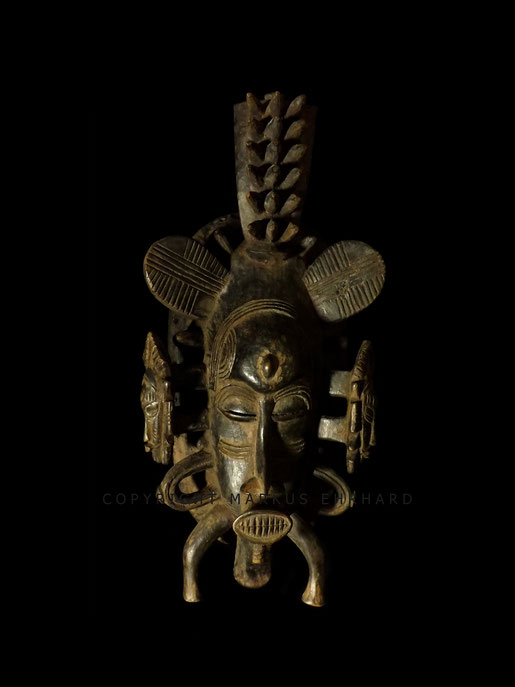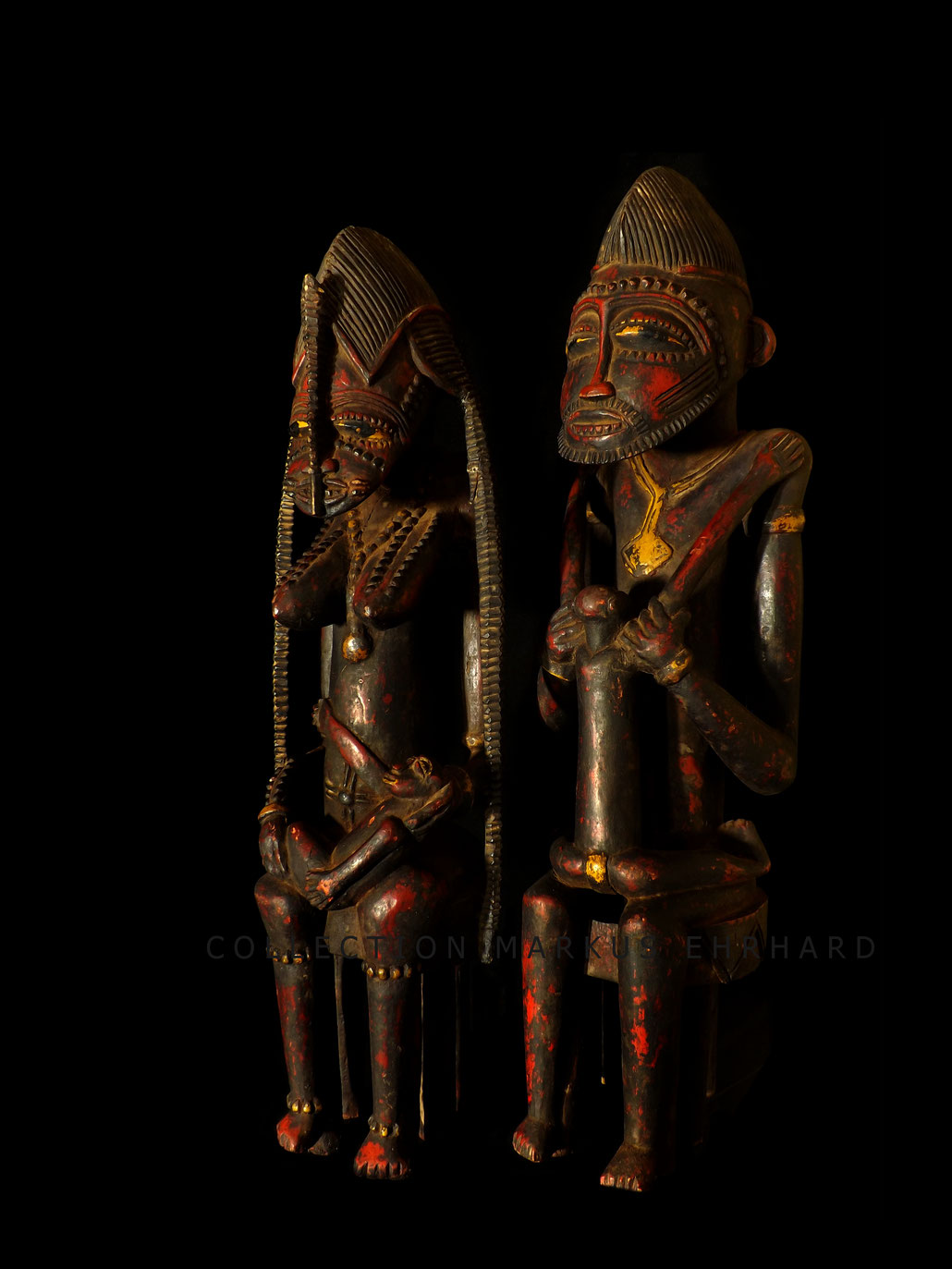Ziehouo Coulibaly, * 1941

"My daily environment is my inspiration. I do nothing coincidentally. I follow my heart. That´s why my masks are different. I try to express how I life and my life in our society", said Ziehouo Coulibaly in February 2015.
Ziehouo Coulibaly, born 1941 in Korhogo, is a Koulé. He is known for his very elaborated masks with a characteristic handwriting.
In certain interviews hold in the past four years, he said, that he started carving when he was 12 years old and that he learned from his father. Ziehouo had 11 pupils who he gave his skills and knowledge.
These days he takes a piece of wood in his hands and plays a bit, but he does not carve anymore. He created so many sculptures, that he doesn't know how many he made, he never counted. For a mask, he said, he needed two weeks to carve them.
Ziehouo Coulibaly is a Daleguee, which is a carver who is allowed to carve a mask with a face. He works with the Katal, a hatchet with a long wooden handle. His style is extravagant, but not flamboyand. The centre figures on top of his Kplié masks always show scenes of Senufo life, like a flute player or drummer.
Ziehouo Coulibaly is one of the last living masters, who is working in the traditional Senufo style. Thought there are tremendous prices in auctions for antique objects, Ziehouo and his work is representative for the dilemma of the today's art- and collector's scene: His work is totally undervalued. After he finished carving a mask, he is selling it to a diviner, a secret society or a Haussa, trades people, who deal also with African sculptures. The quality of his work is always the same, he does not differenciate between the usage in tribe or the so-called airprot-art. Following you will see masks treated with black stain and one coloured mask because of ritual background and two masks treated with dye and funriture polish because of commercial sale. One mask was bought for € 28 on Ebay. What you find today is a mixture of authentic background and on-line commerce. This is why it is so important to know the name of the carver, to understand the artisticly created and not artifcially generated price. Ziehouo is the originator and carving provides his living existenz. That's why it is important, even to collect Airport-art, to know and name the carver. In our art-scene artists and their names became brands, like fashion labels.
After Ziehouo Coulibaly saw his image in an article written by Markus Ehrhard for the Kunst & Kontext Magazine, he hired a bike and went to a diviner out of Korhogo to get this coloured Tugubele couple. "When my work will be in a book, I want this couple to be shown as my best carving! These two statues express the adoration of the Senufo women. Most important in Senufo life is the family. That is why I carve this couple with children. That is the Senufo legend." Ziehouo Coulibaly.
Later on he disclosed, that the diviner used dye to give this couple certain power. Ziehouo did not colour these statues himself. Asking him about the time of creation he answered, that he can't remember, it was too long ago.
Tugubele couple, carved by Ziehouo Coulibaly, Koulé from Korhogo.
Man: 59,0 x 15,5 x 15,0 cm, wood.
Woman: 53,0 x 15,0 x 13,0 cm, wood.
Literature:
- Wenn Neuordnug Ordnung schafft, Markus Ehrhard, pages 166 - 169.

Ziehouo Coulibaly did carve this Kpelié mask of the genre, where a Tugubele figure hold up risings horns.
The diviner did the coloration, not the carver. Color in form of dye or paint is used after 1950 by the Senufo to give an object more spiritual power. Asking why a mask or statue is coloured like this, "the spirits did let me do that" is the main answer.
The mask looks colorful and not colored. Using paint is also an expression of beauty and elegance in Senufo tribe.
Kpelié mask, carved by Ziehouo Coulibaly, Koulé from Korhogo.
37,0x 16,5 x 8,5 cm, wood and paint.
Literature:
- Wenn Neuordnung Ordnung schafft, Markus Ehrhard, pages 170 - 173.
This shown Kpelié is one of the last manufactured masks by Ziehouo Coulibaly from Korhogo. The centre figure displays a drum player. This mask is an example of a recently in tribe used object and it shows, that the characteristic elements of the traditional Kpelié have not changed since +- 150 years.
Kpelié mask, carved by Ziehouo Coulibaly, Koulé from Korhogo.
35,0 x 16,5 x 9,0 cm, wood.
Literature:
- Wenn Urform Form bestimmt, Markus Ehrhard, pages 114 - 115.

Kpelié mask, carved by Ziehouo Coulibaly, Koulé from Korhogo, for the Poro.
28,5 x 13,0 x 7,5 cm, wood.
Literature:
- Wenn Neuordnung Ordnung schafft, Markus Ehrhard, pages 174 - 175.
These three Kpelié masks represent the typical style of Ziehouo Coulibaly. Extravagant, but not loud or too spectacular. All three are used in traditional ceremonies, are treated with black stain and show different traces of usage. Ziehouo's masks are small, the faces tiny are surrounded by decorated elements. Similar to Bakari Coulibaly from Dickodougou, Ziehouo Coulibaly's handwriting is very characteristic because of the complex composition.
Left: Kpelié mask, carved by Ziehouo Coulibaly, Koulé from Korhogo.
32,5 x 16,5 x 8,0 cm, wood. Used in ritual.
Middle: Kpelié mask, carved by Ziehouo Coulibaly, Koulé from Korhogo.
37,5 x 13,5 x 9,05cm, wood. Used in ritual.
Right: Kpelié mask, carved by Ziehouo Coulibaly, Koulé from Korhogo.
33,5 x 13,0 x 7,5 cm, wood. Airport-art.
Literature:
- Wenn Urform Form bestimmt, Markus Ehrhard, pages 116 - 117.
Ziehouo Coulibaly does not distinguish between a mask he is carving for ritual use or for commercial sale. He always claims to create a great mask. In comparison, both masks are carved in the same demand on quality.
The difference is the finish of the two masks. The authentic one does show the traditional black stain treatment, where the mask receives addional power in ritus. The left mask is a typical example for the so-called Airport-art, a mask that is especially made to sell e.g. to tourists. This mask smells like furniture polish, and so it is shinny and glossy.
Left: Kpelié mask, carved by Ziehouo Coulibaly, Koulé from Korhogo.
35,0 x 16,5 x 9,0 cm, wood. Used in ritual.
Right: Kpelié mask, carved by Ziehouo Coulibaly, Koulé from Korhogo.
35,0 x 16,5 x 9,0 cm, wood. Airport-art.
Literature:
- Wenn Urform Form bestimmt, Markus Ehrhard, pages 114 - 115.

Ziehouo did indentify this mask as his work, he sold it to an art dealer. The finish is different to the tradional used black stain. The colour of the mask is in a lighter reddish tone, the surface is brush treaded to make it look antique.
Picture this: € 28 for two weeks of carving.
Yêchikpleyégué mask, carved by Ziehouo Coulibaly, Koulé from Korhogo.
31,5 x 14,5 x 7,5 cm, wood. Airport-art, bought on Ebay for € 28,-.
Literature:
- Wenn Urform Form bestimmt, Markus Ehrhard, pages 117.

Welcome to the first archive documentating the artwork of 26 named Senufo carvers from 1900 till today. We present antique and recent sculptures of so-called masters and not that famous carvers.
All our images have copyright markings. Feel free to download our content and images. In case you publish or share our content or an image on other platforms, like Facebook or Pinterest, please name the source and link to this website. All images are highly detailed printed with more information in our books, available at Ornito.









